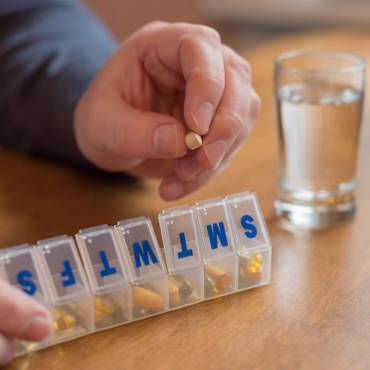Osteoporosis is a condition in which bones of the body become very weak and fragile. This article will help you to know more about osteoporosis and osteoporosis medications.
Osteoporosis is a disease of the bones that can affect life. Millions of women around the world already are suffering from or are at risk of osteoporosis. This disease can cause severe pain and discomfort in the whole body.
Bones: Bones are made up of collagen protein, calcium, and minerals. The inner structure of the bone is made up of the mesh of trabecular bones that look like the honeycomb. Bone cells keep on changing throughout the life where the old and worn out cells called osteoclasts are replaced by osteoblasts or the new bone cells. In childhood, the complete renewal of the skeleton takes places in two years while as we age the process slows down to as low as ten years.
Bones affected due to Osteoporosis:
Although osteoporosis affects all bones of the body, yet the common fragile bones are of regions like hips, wrists, and vertebrae (or spine). If osteoporosis hit the vertebral region, then it can create several problems in females as any fracture in this area can cause hindrance in the day to day activities.
Some common signs of osteoporosis are:
- Slanting shoulders
- Back pain
- Loss of height
- The curve in the back
- Bent/hunched posture
- Protruding abdomen
Also Read: How to Deal with Stress in a Scientific Manner
Risk factors of getting Osteoporosis:
There are some risk factors that can control your chances of getting osteoporosis. Some of these factors can be controlled while others cannot be controlled:
- Old age or over 65 years of age
- Being female
- Menopause stage in women
- The family history of osteoporosis
- Having a small and thin body
- Having a disorder like arthritis, premature menopause, type I diabetes and anorexia nervosa can trigger osteoporosis
- Less exercise and less activity
- Females who are not getting regular menstrual periods
- The long-term use of antacids, anti-seizure, cancer treatment, and asthma medications, etc. can trigger osteoporosis
- Too much of smoking and alcohol consumption
Consequences of Osteoporosis:
Having osteoporosis doesn’t mean that your bones will break automatically. Instead, osteoporosis is a condition where the chances of your bone fracture are more during a fall or an injury. It is because, after the age of around 35, bone loss increases (in the form of calcium, collagen, and other minerals. It leads to osteoporosis and increased the risk of bone fracture.
Diagnosis:
There are some tests that are used to verify the presence of the condition of osteoporosis. One of the tests is DXA or Dual-energy X-ray Absorptiometry. This test is used to take a high definition X-ray of your bones. This test can:
- Check the bone strength
- Diagnose if you have osteoporosis or whether you are likely to break a bone or not
- Check if the treatments are doing good to your bones or not
Treatment of Osteoporosis:
Treatment option includes osteoporosis medications (on the recommendation by a doctor), a balanced diet rich in Vitamin D and calcium, daily exercise, and a healthy lifestyle change. Before taking any drug for the treatment, you must always take advice from your doctor. Some of the approved osteoporosis medications are:
- Bisphosphonates:
These are used for the prevention and treatment of postmenopausal osteoporosis. These drugs can help to build bone mass.
- Selective estrogen receptor modulators or (SERMS):
They are also used for treatment and prevention of postmenopausal osteoporosis. They work by slowing the rate of bone loss.
- Calcitonin:
It is a natural hormone that is helpful in the prevention of loss of bone calcium Apart from these medications for osteoporosis your doctor may also recommend therapies such as:
- Menopausal hormone therapy
- Parathyroid hormonal therapy
Ways to prevent osteoporosis:
Many times being a woman you might wonder if osteoporosis can be prevented. There are many ways to keep your bone healthy and strong and slow down the process of bone loss.
Nutrition: Along with osteoporosis medications, a healthy diet rich in nutrients, calcium, and vitamin D is very necessary to ensure bone health. Many women ignore this thing, and their total calcium uptake is less than half of what is required by the body.
Here is the daily calcium requirement chart:
Age Milligrams (mg) per day 9-18 1300 19-50 1000 51 and older 1200
Rich sources of calcium include tofu, milk, spinach, beans, and yogurt.
Daily Vitamin-D requirement chart:
Age International Units (IU) Per day 19-70 600 71+ 800
Although very less amount of vitamin D is available from food, yet some sources of vitamin D are cooked salmon, milk and egg yolk.
Exercise: It is one of the major bone strength developers. You can develop strong bones and muscles by doing weight-bearing activities that work against gravity like yoga, weight lifts, walking, jogging, and climbing stairs, etc.
Learn to manage stress: If you are stressed, you probably have high levels of cortisol levels. The high level of cortisol for long periods may contribute to bone loss. Therefore, it is necessary to include specific activities for stress reduction in your daily routine. These activities include meditation, yoga, prayer, and massage. Taking a vacation, and getting psychotherapy to help with disturbed relationships can assist you with stress reduction.
Get enough sleep: A research study found that men and women over the age of 50 who slept less than six hours are at high risk of osteoporosis. Adults are required to sleep for 7 to 8 hours to awaken refreshed.
Preventing falls: Falls can break bones. You can prevent falls by following simple household precautionary measures like putting grab bars on bathroom walls, using carpet runners on slippery floors, adding more light to the room, etc.
Also Read: Green Tea: Amazing Health benefits You Never Knew About!
Conclusion:
Osteoporosis is a major problem among women these days, however, if they take proper care of themselves, they can surely prevent the consequences and pains one has to face during osteoporotic fractures. We should not be ignorant about our bone health and should take appropriate steps to improve our health before it’s too late.



